A visit to the three spaces of the Paul Kasmin Gallery in Chelsea in New York City offers an enlivening education in the power of three of the backbones of traditional art-making: painting, drawing, and sculpture.
The Hamptons’ own Lee Krasner demonstrates the expressive possibilities of the first medium in “The Umber Paintings, 1959 – 1962,” while “David Hockney: Works on Paper, 1961 – 2009” provides a close-up view of the world of the beloved British painter, who is currently the subject of a major exhibition at The Met. In the plastic arts, the Mexican artist Bosco Sodi reveals the transfixing, restorative power of minimalist sculpture as seen through the lens of nature.
“Lee Krasner: The Umber Paintings, 1959 – 1962”
Viewed within the modern monastic space of the Paul Kasmin Gallery, with its cool white walls, polished floors, and concrete ceiling, the visceral earth tones and frantic forms of Lee Krasner’s “Umber Paintings” emerge as fields of boundless energy. This is the gallery’s first Krasner exhibition since it was chosen to represent the artist by the Pollock-Krasner Foundation last year, with the intention that the gallery will increase recognition of Krasner’s work. Indeed, in reviewing this show it is tempting not to mention Jackson Pollock, in order to give Krasner her due as one of the preeminent Abstract Expressionist artists in her own right, and to see the works freed from the specter of her famous husband.
But the stylistic affinity with Pollock of the paintings on view means that not to reference their relationship would be disingenuous. Krasner herself recognized the biographical nature of her work, and the knowledge that these paintings were created just a few years after Pollock’s untimely death in 1956, and after the death of Krasner’s mother in 1959, is significant.
Not only did acute insomnia at this time cause Krasner to begin working at night, and thus adopt a more restricted palette than before, but she had also begun painting in Pollock’s studio at their home in East Hampton’s Springs (previously she had worked in a room in the house). This allowed the artist to use much larger canvases than she had previously, and it is also apparent that the spirit of Pollock and their fiery relationship influenced Krasner’s creative process during this period. What emerged is a series of 24 emotionally raw paintings that nevertheless bristle with life. Five of these are on view at Paul Kasmin.
A palette of brown shades of umber, as well as black, white, and cream, unites the five works on display, but each painting has its own distinct painterly expression. In the case of Seeded (1960), the first work on the right as visitors enter the gallery, these colors are amalgamated in an energetic mass of swirls, curves, bold lines, and planes of color that are further enlivened by patches of canvas left bare.
A similar sense of movement animates Moontide (1961), but here the paint is more thickly applied, with glistening daubs of pigment. This is the exhibition’s only horizontally aligned canvas and the picture plane here appears to unfold, recalling the unraveling motion of Chinese and Japanese scroll painting and—as indicated by the work’s title and emphasized by its green hues—the undulation of waves.
.
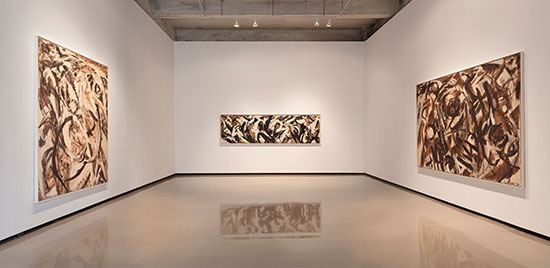
"Fecundity," "Moontide" and "Seeded." by Lee Krasner. © 2017 The Pollock-Krasner Foundation / Artists Rights Society (ARS), New York. Courtesy of Paul Kasmin Gallery. Photo: Diego Flores / Paul Kasmin Gallery.
.
In contrast to the lilting, rhapsodic vitality of Moontide, other canvases are painted more frenetically, with animalistic force. Growling, mask-like features appear to emerge from Fecundity (1960), while the mix of thick and thin, sweeping brushstrokes and splatters of paint of Uncaged (1960) creates a mass of energy. Although the palette is somber in the latter work, the composition is a whirling dervish. It cannot help but bring to mind the figure of the artist throwing herself at the canvas.
.

"Fecundity" by Lee Krasner, 1960. Oil on canvas, 87 3/8 x 70 1/2 inches. © 2017 The Pollock-Krasner Foundation / Artists Rights Society (ARS), New York. Courtesy of Paul Kasmin Gallery. Photo: Diego Flores / Paul Kasmin Gallery.
.
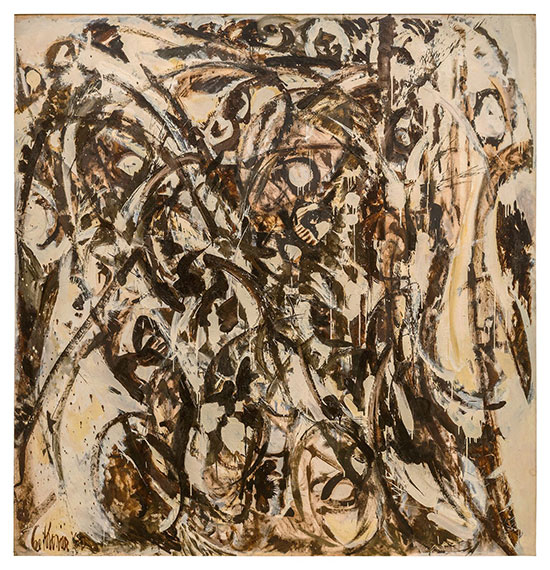
"Uncaged" by Lee Krasner, 1960. Oil on canvas, 96 7/8 x 93 1/2 inches. ©2017 The Pollock-Krasner Foundation / Artists Rights Society (ARS), New York. Image courtesy of Paul Kasmin Gallery.
.
A similar self-expressionism is evident in the exhibition’s final painting, Assault On the Solar Plexus (1961). On a largely bare canvas, light brown splatters of paint are featherlike in appearance. Considered alongside the other four canvases, which in form and by their titles move between hope and rage, it is unclear whether the brushstrokes here reference the feathers of birds’ wings, or birds splattered by an unknown force. The title would seem to indicate the latter, but in these vital works there is the sense that from the deepest despair, a life-affirming creativity will emerge.
.

"Assault On the Solar Plexus" by Lee Krasner, 1961. Oil on cotton duck, 81 x 58 inches. © 2017 The Pollock-Krasner Foundation / Artists Rights Society (ARS), New York. Image courtesy of Paul Kasmin Gallery.
.
“David Hockney: Works on Paper, 1961 – 2009”
Like the exhilarating Hockney retrospective currently at The Met, the Paul Kasmin Gallery’s “David Hockney: Works on Paper, 1961 – 2009” displays images from different stages of the artist’s long career. This includes his rougher, more Bohemian works created while a student at the Royal College of Art in London up to his recent Yorkshire landscapes.
.

"David Hockney: Works on Paper, 1961-2009" at Paul Kasmin Gallery. Photo: Diego Flores. Courtesy of the Paul Kasmin Gallery.
.
These latter charcoal drawings offer helpful insights seen in relation to the large, brightly colored oil on canvas landscapes from the same period installed uptown. For instance, Autumn Thixendale, October 19th, 2008, at Paul Kasmin, with its ground of parallel hatching and the softly smudged forms of trees and hedgerows, allows more intimate access to Hockney’s initial working process and to his view of a quietly vibrant natural world.
.
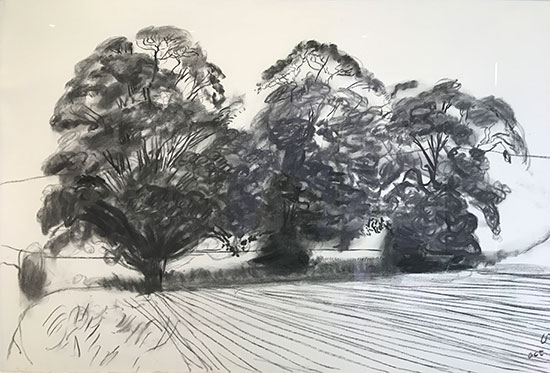
"Autumn Thixendale, October 19th" by David Hockney. Photo: Sally Grant.
.
Characteristically, in capturing the world around him Hockney frequently depicts his friends and lovers and there are a number of portraits on display. For Peter Langan (1981), the late co-owner of London’s legendary Langan’s Brasserie, the summary marks of ink that make up the corpulent subject’s profile, including his frizzy hair and facial stubble, succinctly captures the rambunctious, bibulous restaurateur. By contrast, the full-length portrait, Kasmin (1973), is more finely rendered in pencil. This depicts Paul Kasmin’s father, John, Hockney’s first dealer in London. Their friendship is marked by a couple of other portraits, including one of Paul Kasmin as a young boy, For Paul With Love David, 1965.
.
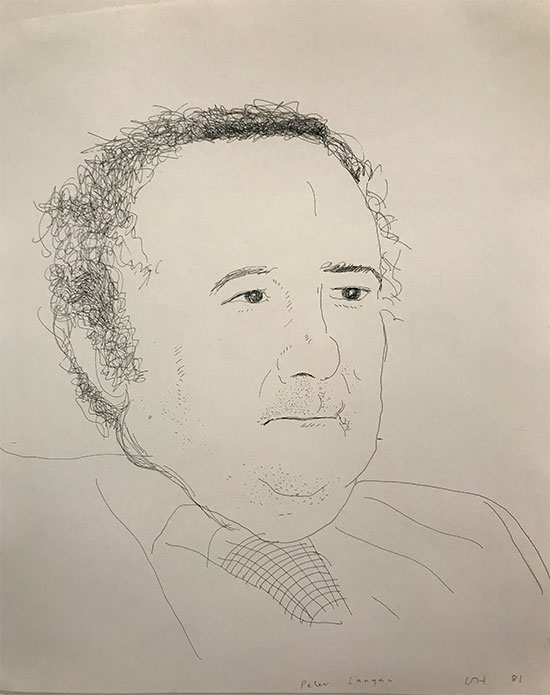
"Peter Langan" by David Hockney. Photo: Sally Grant.
.
Above all, like his paintings, these works on paper convey Hockney’s absolute glee in viewing the world and frequently his (very British) sense of humor. An artist known for his dapper dress, Hockney’s delight in fabric—and its visual replication—can be seen in the subject’s partially completed plaid tie in Kasmin, as though any more detail would spoil the marvel of artistic manufacture. Hockney’s humor is apparent in works such as Crawling Insects, 1961, where scratched-out figures are accompanied by a trail of insects drawn in ink, as though, frustrated with his depictions of the human figure, the artist decided to draw tiny bugs instead.
Likewise, his colorful drawing Joseph Andrews (listed as c. 1972, which seems suspect), advertising the 1977 British comedy film of the same title and the multicolored Piccadilly Theatre billboard collage, Drawing for‘The Threepenny Opera’ (1972) replicate the spirited, debauched, and bawdy characters that these film and theater representations celebrate. They are ideal Hockney subjects.
“Bosco Sodi: Caryatides”
Rounding out this triptych of artistic mediums are Bosco Sodi’s sculptural “Caryatides,” on view at the gallery’s 27th Street space until January 6, 2018. The installation consists of a series of pillars of stacked clay cubes and, while their simplified forms recall the sculptural minimalism of artists such as Richard Serra, their organic material and warm, reddish-orange coloring convey a strong sense of living presence. This is accentuated by the different heights of the pillars, as though they represent different stages in life and—by way of their imperfect stacking and fissured forms—evoking human frailty.
.

"Bosco Sodi: Caryatides" at Paul Kasmin Gallery. Courtesy of Paul Kasmin Gallery.
.
The exhibition is presented in two spaces, with a white wall acting as a divider. In the main room a large, red, mixed media work is affixed to this dividing wall. Set on a thick linen canvas, a mix of pigment, wood pulp and natural fibers creates a three-dimensional work that appears to explode from its support. This volcanic-like mass moves from a heavily encrusted lower section upwards to red flames of pigment, which bleed around the canvas edges.
.
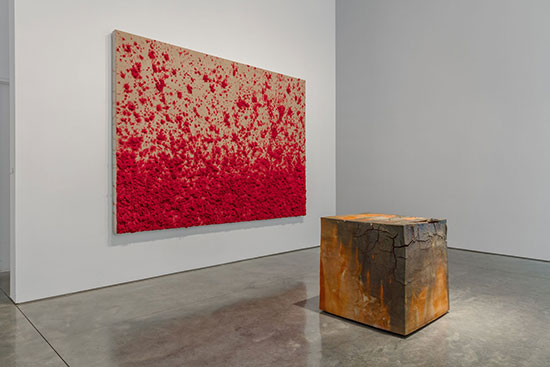
"Bosco Sodi: Caryatides" at Paul Kasmin Gallery. Courtesy of Paul Kasmin Gallery.
.
In the second space, where a single, charred and fractured clay cube is located, similar red works—one small and one large—hang on opposing walls. While these are still sculptural, the canvases are more contained than in the other room. Here there is the sense that the volcanic strata are gradually settling.
Walking among the Caryatides in the main section of the gallery, with its white walls and opaque glass roof, a quiet stillness pervades. Like Lee Krasner’s paintings, though, the works’ warm earth tones, juxtaposed with the coolness of the space, create a sense of living vitality. The title of Sodi’s exhibition also reminds the viewer of the antique origin of the name, caryatid, given to describe an architectural, supporting column in the form of a female figure.
.
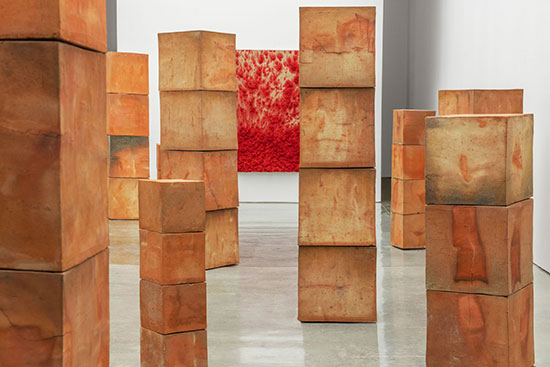
"Bosco Sodi: Caryatides" at Paul Kasmin Gallery. Courtesy of Paul Kasmin Gallery.
.
There is a sense of sharing a space with an ancient culture, one subject to the destructive vagaries of nature, as implied by the volcanic wall canvas. And yet, though the single clay cube in the second room is burnt and damaged, it still survives as the dust settles once again. With this sense of continuance and renewal, and with the energizing art of Krasner and Hockney nearby, the Paul Kasmin Gallery is presenting very fitting exhibitions to see in the first days of the New Year.
________________________
BASIC FACTS: “Lee Krasner: The Umber Paintings, 1959 – 1962” and “David Hockney: Works on Paper, 1961 – 2009” are on view November 9, 2017 to January 13, 2018 at Paul Kasmin Gallery, 293 Tenth Avenue and 297 Tenth Avenue; “Bosco Sodi: Caryatides” is on view November 2, 2017 to January 6, 2018 at 515 W. 27th Street, New York, NY 10001. The gallery will be closed for the holidays from December 22, 2017 to January 1, 2018 and will reopen on January 2, 2018. paulkasmingallery.com
_________________________
Copyright 2017 Hamptons Art Hub LLC. All rights reserved.
